Related Research Articles
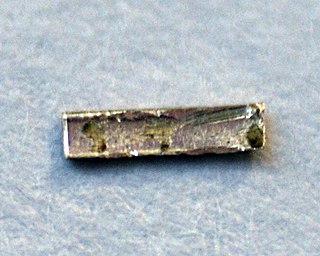
Radium is a chemical element with the symbol Ra and atomic number 88. It is the sixth element in group 2 of the periodic table, also known as the alkaline earth metals. Pure radium is silvery-white, but it readily reacts with nitrogen (rather than oxygen) upon exposure to air, forming a black surface layer of radium nitride (Ra3N2). All isotopes of radium are radioactive, the most stable isotope being radium-226 with a half-life of 1,600 years. When radium decays, it emits ionizing radiation as a by-product, which can excite fluorescent chemicals and cause radioluminescence.

Radioactive waste is a type of hazardous waste that contains radioactive material. Radioactive waste is a result of many activities, including nuclear medicine, nuclear research, nuclear power generation, nuclear decommissioning, rare-earth mining, and nuclear weapons reprocessing. The storage and disposal of radioactive waste is regulated by government agencies in order to protect human health and the environment.

Uraninite, also known as pitchblende, is a radioactive, uranium-rich mineral and ore with a chemical composition that is largely UO2 but because of oxidation typically contains variable proportions of U3O8. Radioactive decay of the uranium causes the mineral to contain oxides of lead and trace amounts of helium. It may also contain thorium and rare-earth elements.
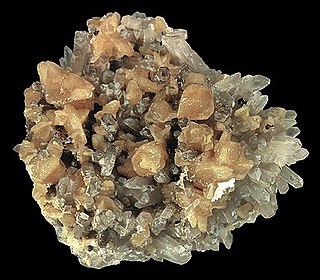
Monazite is a primarily reddish-brown phosphate mineral that contains rare-earth elements. Due to variability in composition, monazite is considered a group of minerals. The most common species of the group is monazite-(Ce), that is, the cerium-dominant member of the group. It occurs usually in small isolated crystals. It has a hardness of 5.0 to 5.5 on the Mohs scale of mineral hardness and is relatively dense, about 4.6 to 5.7 g/cm3. There are five different most common species of monazite, depending on the relative amounts of the rare earth elements in the mineral:

In nuclear science, the decay chain refers to a series of radioactive decays of different radioactive decay products as a sequential series of transformations. It is also known as a "radioactive cascade". The typical radioisotope does not decay directly to a stable state, but rather it decays to another radioisotope. Thus there is usually a series of decays until the atom has become a stable isotope, meaning that the nucleus of the atom has reached a stable state.

In mining, tailings or tails are the materials left over after the process of separating the valuable fraction from the uneconomic fraction (gangue) of an ore. Tailings are different from overburden, which is the waste rock or other material that overlies an ore or mineral body and is displaced during mining without being processed.
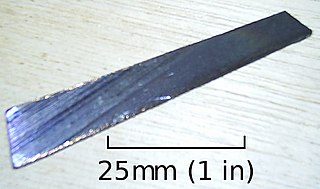
Uranium-238 is the most common isotope of uranium found in nature, with a relative abundance of 99%. Unlike uranium-235, it is non-fissile, which means it cannot sustain a chain reaction in a thermal-neutron reactor. However, it is fissionable by fast neutrons, and is fertile, meaning it can be transmuted to fissile plutonium-239. 238U cannot support a chain reaction because inelastic scattering reduces neutron energy below the range where fast fission of one or more next-generation nuclei is probable. Doppler broadening of 238U's neutron absorption resonances, increasing absorption as fuel temperature increases, is also an essential negative feedback mechanism for reactor control.
K-65 residues are the very radioactive mill residues resulting from the uniquely concentrated uranium ore discovered before WW II in Katanga province of the Democratic Republic of the Congo.
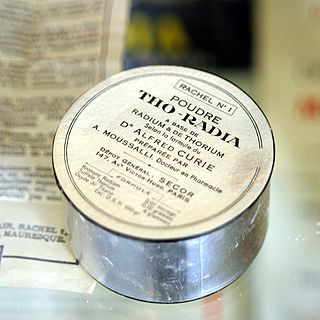
Radioactive quackery is quackery that improperly promotes radioactivity as a therapy for illnesses. Unlike radiotherapy, which is the scientifically sound use of radiation for the destruction of cells, quackery pseudo-scientifically promotes involving radioactive substances as a method of healing for cells and tissues. It was most popular during the early 20th century, after the discovery in 1896 of radioactive decay. The practice has widely declined, but is still actively practiced by some.

Uranium mining is the process of extraction of uranium ore from the ground. Over 50 thousand tons of uranium were produced in 2019. Kazakhstan, Canada, and Australia were the top three uranium producers, respectively, and together account for 68% of world production. Other countries producing more than 1,000 tons per year included Namibia, Niger, Russia, Uzbekistan, the United States, and China. Nearly all of the world's mined uranium is used to power nuclear power plants. Historically uranium was also used in applications such as uranium glass or ferrouranium but those applications have declined due to the radioactivity of uranium and are nowadays mostly supplied with a plentiful cheap supply of depleted uranium which is also used in uranium ammunition. In addition to being cheaper, depleted uranium is also less radioactive due to a lower content of short-lived 234
U and 235
U than natural uranium.

Environmental radioactivity is not limited to actinides; non-actinides such as radon and radium are of note. While all actinides are radioactive, there are a lot of actinides or actinide-relating minerals in the Earth's crust such as uranium and thorium. These minerals are helpful in many ways, such as carbon-dating, most detectors, X-rays, and more.

Radium and radon are important contributors to environmental radioactivity. Radon occurs naturally as a result of decay of radioactive elements in soil and it can accumulate in houses built on areas where such decay occurs. Radon is a major cause of cancer; it is estimated to contribute to ~2% of all cancer related deaths in Europe.
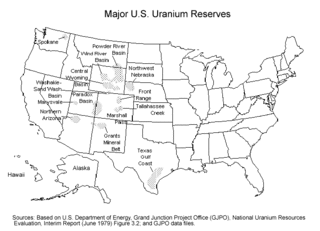
Uranium mining in the United States produced 173,875 pounds (78.9 tonnes) of U3O8 in 2019, 88% lower than the 2018 production of 1,447,945 pounds (656.8 tonnes) of U3O8 and the lowest US annual production since 1948. The 2019 production represents 0.3% of the anticipated uranium fuel requirements of the US's nuclear power reactors for the year.
Naturally occurring radioactive materials (NORM) and technologically enhanced naturally occurring radioactive materials (TENORM) consist of materials, usually industrial wastes or by-products enriched with radioactive elements found in the environment, such as uranium, thorium and potassium and any of their decay products, such as radium and radon. Produced water discharges and spills are a good example of entering NORMs into the surrounding environment.

Uranium tiles have been used in the ceramics industry for many centuries, as uranium oxide makes an excellent ceramic glaze, and is reasonably abundant. In addition to its medical usage, radium was used in the 1920s and 1930s for making watch, clock and aircraft dials. Because it takes approximately three metric tons of uranium to extract 1 gram of radium, prodigious quantities of uranium were mined to sustain this new industry. The uranium ore itself was considered a waste product and taking advantage of this newly abundant resource, the tile and pottery industry had a relatively inexpensive and abundant source of glazing material. Vibrant colors of orange, yellow, red, green, blue, black, mauve, etc. were produced, and some 25% of all houses and apartments constructed during that period used bathroom or kitchen tiles that had been glazed with uranium. These can now be detected by a Geiger counter that detects the beta radiation emitted by uranium's decay chain. In most situations, the radiation exposure is not excessive, but there may be exceptions for pure uranium oxide on bathroom floors, which can pose a hazard for infants crawling around.
Radon-222 is the most stable isotope of radon, with a half-life of approximately 3.8 days. It is transient in the decay chain of primordial uranium-238 and is the immediate decay product of radium-226. Radon-222 was first observed in 1899, and was identified as an isotope of a new element several years later. In 1957, the name radon, formerly the name of only radon-222, became the name of the element. Owing to its gaseous nature and high radioactivity, radon-222 is one of the leading causes of lung cancer.

The Church Rock uranium mill spill occurred in the U.S. state of New Mexico on July 16, 1979, when United Nuclear Corporation's tailings disposal pond at its uranium mill in Church Rock breached its dam. The accident remains the largest release of radioactive material in U.S. history, having released more radioactivity than the Three Mile Island accident four months earlier.
The Jaduguda Mine is a uranium mine in Jaduguda village in the Purbi Singhbhum district of the Indian state of Jharkhand. It commenced operation in 1967 and was the first uranium mine in India. The deposits at this mine were discovered in 1951. As of March 2012, India possesses eight functional uranium mines, including this Jaduguda Mine. A new mine, Tummalapalle uranium mine is discovered and mining is going to start from it.

Uranium acid mine drainage refers to acidic water released from a uranium mining site using processes like underground mining and in-situ leaching. Underground, the ores are not as reactive due to isolation from atmospheric oxygen and water. When uranium ores are mined, the ores are crushed into a powdery substance, thus increasing surface area to easily extract uranium. The ores, along with nearby rocks, may also contain sulfides. Once exposed to the atmosphere, the powdered tailings react with atmospheric oxygen and water. After uranium extraction, sulfide minerals in uranium tailings facilitates the release of uranium radionuclides into the environment, which can undergo further radioactive decay while lowering the pH of a solution.
References
- 1 2 Uranium Mill Tailings. U.S.NRC, update 12 March 2020
- 1 2 Backgrounder on Uranium Mill Tailings. U.S.NRC, update 21 Sep 2020
- ↑ Grammer, Elisa J. (1981), "The Uranium Mill Tailings Radiation Control Act of 1978 and NRC's Agreement State Program", Natural Resources Lawyer, 13 (3): 469–522, JSTOR 40922651
- ↑ Uranium Mining and Milling: A Primer. The Workbook, Vol. IV, issue=6–7; Southwest Research & Information Center, Nov/Dec 1979 (archived, 2.8 MB)
- ↑ Peter Diehl. "Uranium Mining and Milling Wastes: An Introduction" . Retrieved 2009-10-02.